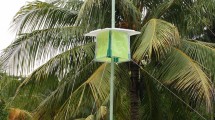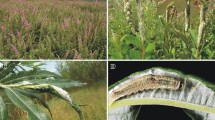Abstract
Dispersal of eriophyoid mites is crucial for the successful colonization of new plants. Literature suggests that their long-distance dispersal is through aerial transfer. During dispersal, eriophyoids might be captured in vapor or fine drops of water (perhaps most likely in clouds) where they might be protected against water loss and desiccation, but where they would have no food and be exposed to low temperatures and oxygen concentrations. Considerable resistance of these mites to these stressful environmental conditions is expected and has only partly been confirmed experimentally. The aim of the bioassays conducted here was to assess the survival of five eriophyoid species off their host plants, with poor oxygen availability under two temperature regimes. The bioassays were carried out on live mites dipped into two media used as microenvironments: (1) vaseline oil (used also as control treatment), and (2) water solution of Tween 80 (0.2%) and cycloheximide (50 mg/l). The bioassays were performed at 5 ± 1 and 25 ± 1 °C. The survival of mites was assessed weekly (5 °C) or daily (25 °C) by counting live and active specimens. The following species were subjected to the bioassays: Aceria caulobia (a stem gall mite), Aceria ficus (a vagrant mite), Cecidophyopsis hendersoni (a vagrant mite), Colomerus vitis (protogyne/male population and deutogyne morphs; a leaf gall mite) and Phytoptus avellanae (a bud gall mite). The survival rate of the mites was higher at 5 °C than at 25 °C under both experimental conditions. At 5 °C, the survival of almost all species was higher in the water solution (up to 6–7 weeks) than in vaseline oil (3–5 weeks). Longer survival was found for A. caulobia and P. avellanae (gall-making species) than for C. hendersoni and A. ficus (vagrant species). As expected, the deutogynes of C. vitis survived longer than its protogynes. The current results suggest that individuals of some of the tested species are well suited for withstanding cold, starvation and low oxygen rates, which could be found at higher atmospheric layers, within the clouds, allowing them an effective long-distance dispersal.


Similar content being viewed by others
References
Amendola A, Cerioli NL (2006) L’ecotossicologia negli ambienti acquatici. APAT—Servizio Stampa ed Editoria, Roma. Rapporto 71/2006, pp 111 ISBN: 88-448-0188-4
Bergh JC (2001) Ecology and aerobiology of dispersing citrus rust mites (Acari: Eriophyidae) in central Florida. Environ Entomol 30:318–326. https://doi.org/10.1603/0046-225X-30.2.318
Bergh JC, McCoy CW (1997) Aerial dispersal of citrus rust mite (Acari: Eriophyidae) from Florida citrus groves. Popul Ecol 26:256–264. https://doi.org/10.1093/ee/26.2.256
Bernard MB, Horne PA, Hoffmann AA (2005) Eriophyoid mite damage in Vitis vinifera (grapevine) in Australia: Calepitrimerus vitis and Colomerus vitis (Acari: Eriophyidae) as the common cause of the widespread ‘Restricted Spring Growth’ syndrome. Exp Appl Acarol 35:83–109. https://doi.org/10.1007/s10493-004-1986-4
Britto EPJ, Gondim MG Jr, Navia D, Flechtmann CHW (2008) A new deuterogynous mite (Acari: Eriophyoidae) with dimorphic males from Caesalpinia echinata (Caesalpiniaceae) from Brazil: description and biological observations. Int J Acarol 34:307–316. https://doi.org/10.1080/01647950808684547
Cox DR (1972) Regression models and life-tables. J R Stat Soc Ser B 34:187–220
Cox DR, Oakes D (1984) Analysis of survival data. Chapman and Hall, London
David PMM, Varadarajan MK (2001) A new glycerine drop trap method to sample eriophyoid mites. Entomon 26:97–100
de Lillo E, Monfreda R (2004) «Salivary secretions» of eriophyoids (Acari: Eriophyoidea): first results of an experimental model. Exp Appl Acarol 34:291–306. https://doi.org/10.1007/s10493-004-0267-6
de Lillo E, Skoracka A (2010) What’s “cool” on eriophyoid mites? Exp Appl Acarol 51:3–30. https://doi.org/10.1007/s10493-009-9297-4
de Lillo E, Craemer C, Amrine JW, Nuzzaci G (2010) Recommended procedures and techniques for morphological studies of Eriophyoidea (Acari: Prostigmata). Exp Appl Acarol 51:283–307. https://doi.org/10.1007/s10493-009-9311-x
Duffner K, Schruft G (1998) Die klebebandmethode zur erfassung des wanderungsverhaltens von krau selmilben. Deut Wein-Jahrb 49:201–206
Duffner K, Schruft G, Guggenheim R (2001) Passive dispersal of the grape rust mite Calepitrimerus vitis Nalepa 1905 (Acari, Eriophyoidea) in vineyards. J Pest Sci 74:1–6. https://doi.org/10.1046/j.1439-0280.2001.01001.x
Frost WE (1997) Polyphenic wax production in Abacarus hystrix (Acari: Eriophyidae), and implications for migratory fitness. Physiol Entomol 22:37–46. https://doi.org/10.1111/j.1365-3032.1997.tb01138.x
Goolsby JA, Zonneveld R, Makinson JR, Pemberton RW (2005) Host-range and cold temperature tolerance of Floracarus perrepae Knihinicki & Boczek (Acari: Eriophyidae), a potential biological-control agent of Lygodium microphyllum (Pteridophyta: Lygodiaceae). Austr J Entomol 44(3):321–330. https://doi.org/10.1111/j.1440-6055.2005.00470.x
Harvey TL, Martin TJ (1988) Sticky tape method to measure cultivar effect on wheat curl mite population in wheat spikes. J Econ Entomol 81:731–734
Keifer HH (1975) Eriophyoidea Nalepa. Injurious Eriophyoid Mites. In: Jeppson LR, Keifer HH, Baker EW (eds) Mites injurious to economic plants. University California Press, Berkeley, pp 327–533
Kiedrowicz A, Kuczyński L, Lewandowski M, Proctor H, Skoracka A (2017) Behavioural responses to potential dispersal cues in eriophyid mites. Sci Rep 7(3890):1–9. https://doi.org/10.1038/s41598-017-04372-7
Krantz GW (1973) Observations on the morphology and behavior of the filbert rust mite, Aculus comatus (Prostigmata: Eriophyoidea) in Oregon. Ann Entomol Soc Am 66:709–717
Lake EC, Smith MC, Pratt PD, Boughton AJ, Pemberton RW (2014) Dispersal and establishment of new populations of the biological control agent Floracarus perrepae (Acariformes: Eriophyidae) on Old World climbing fern, Lygodium microphyllum (Polypodiales: Lygodiaceae). Fla Entomol 97:827–829. https://doi.org/10.1653/024.097.0271
Laska A, Rector BG, Skoracka A, Kuczyński L (2019) Can your behaviour blow you away? Contextual and phenotypic precursors to passive aerial dispersal in phytophagous mites. Anim Behav 155:141–151. https://doi.org/10.1016/j.anbehav.2019.07.003
Lindquist EE, Oldfield GN (1996) Evolution of eriophyoid mites in relation to their host plants. In: Lindquist EE, Sabelis MW, Bruin J (eds) Eriophyoid mites—their biology, natural enemies and control. World crop pests, vol 6. Elsevier Science Publishing, Amsterdam, pp 277–300
Liu S, Li J-L, Guo K, Qiao H, Xu R, Chen J-M, Xu C-Q, Chen J (2016) Seasonal phoresy as an overwintering strategy of a phytophagous mite. Sci Rep 6:25483. https://doi.org/10.1038/srep25483
Malagnini V, de Lillo E, Saldarelli P, Beber R, Duso C, Raiola A, Zanotelli L, Valenzano D, Giampetruzzi A, Morelli M, Ratti C, Causin R, Gualandri G (2016) Transmission of grapevine Pinot gris virus by Colomerus vitis (Acari: Eriophyidae) to grapevine. Arch Virol 161:2595–2599. https://doi.org/10.1007/s00705-016-2935-3
Manson DCM, Oldfield GN (1996) Life forms, deutogyny, diapause and seasonal development. In: Lindquist EE, Sabelis MW, Bruin J (eds) Eriophyoid mites—their biology, natural enemies and control. World crop pests, vol 6. Elsevier Science Publishing, Amsterdam, pp 173–183
Melo JWS, Lima DB, Sabelis MW, Pallini A, Gondim Junior MGC (2014) Behaviour of coconut mites preceding take-off to passive aerial dispersal. Exp Appl Acarol 64:429–443. https://doi.org/10.1007/s10493-014-9835-6
Michalska K, Skoracka A, Navia D, Amrine JW (2010) Behavioural studies on eriophyoid mites-an overview. Exp Appl Acarol 51:31–59. https://doi.org/10.1007/s10493-009-9319-2
Monfreda R, Lekveishvili M, Petanović R, Amrine JW (2010) Collection and detection of eriophyoid mites. Exp Appl Acarol 51:273–282. https://doi.org/10.1007/s10493-009-9315-6
Mukwevho L, Olckers T, Simelane DO (2017) Establishment, dispersal and impact of the flower-galling mite Aceria lantanae (Acari: Trombidiformes: Eriophyidae) on Lantana camara (Verbenaceae) in South Africa. Biol Control 107:33–40. https://doi.org/10.1016/j.biocontrol.2017.01.009
Ozman SK, Goolbsby JA (2005) Biology and phenology of the eriophyid mite Floracarus perrepae, on its native host in Australia, old world climbing fern Lygodium microphyllum. Exp Appl Acarol 35:197–213
Paynter Q, Gourlay AH, Rolando CA, Watt MS (2012) Dispersal of the scotch broom gall mite Aceria genistae: implications for biocontrol. N Z Plant Prot 65:81–84
Reynolds DR, Reynolds AM, Chapman JW (2014) Non-volant modes of migration in terrestrial arthropods. Animal Migr 2:8–28. https://doi.org/10.2478/ami-2014-0002
Sabelis MW, Bruin J (1996) Evolutionary ecology: life history patterns, food plant choice and dispersal. In: Lindquist EE, Sabelis MW, Bruin J (eds) Eriophyoid mites—their biology, natural enemies and control. World crop pests, vol 6. Elsevier Science Publishing, Amsterdam, pp 329–366
Schliesske J (1977) Ausbreitung und Wirtspflanzenkreis von Aculus fockeui Nal. et Trt. (Acari: Eriophyidae) und der mit ihr Vergesellschaften arten. Meded Fac Landbouw Rijk Gent 42:1343–1351
Shevtchenko VG, DeMillo AP (1968) Zhiznennyi tsike Trisetacus kirghisorum V. Shev. (Acarina, tetrapodili)—breditelya cemyan Juniperus semiglobosa Rgl. [Life cycle of Trisetacus kirghisorum V. Shev. (Acarina, Tetrapodili)—pest of Juniperus semiglobosa seeds]. Vestnik Leningr Univ Ser Biol 3:60–67
Slykhuis JT (1955) Aceria tulipae Keifer (Acarina: Eriophyidae) in relation to the spread of wheat streak mosaic. Phytopatology 45:116–128
SPSS IBM Corp. (2011) IBM SPSS statistics for windows, version 20.0. IBM Corp, Armonk
Townsend L, Johnson D (1996) Wheat streak mosaic virus and the wheat curl mite. University of Kentucky, ENTFACT-117. www.ca.uky.edu/entomology/entfacts/ef117.asp. Accessed 22 May 2017
Wosula EN, McMechan AJ, Hein GL (2015) The effect of temperature, relative humidity, and virus infection status on off-host survival of the Wheat Curl Mite (Acari: Eriophyidae). J Econ Entomol 108:1545–1552. https://doi.org/10.1093/jee/tov185
Zhao S, Amrine JW (1997a) Investigation of snowborne mites (Acari) and relevancy to dispersal. Int J Acarol 23:209–213
Zhao S, Amrine JW (1997b) A new method for studying aerial dispersal behaviour of eriophyoid mites (Acari: Eriophyoidea). Syst Appl Acar 2:107–110
Acknowledgements
This research was supported by a Grant from Centro Trasferimento tecnologico—Fondazione Edmund Mach, San Michele all’Adige, Trento, Italy (CTT-FEM) and University of Bari Aldo Moro, Italy. The authors are grateful to Profs. James W. Amrine Jr. (University of West Virginia, USA), Antonella Di Palma (University of Foggia, Italy), Mariusz Lewandowski (Warsaw University of Life Sciences – SGGW, Poland), drs. Sauro Simoni (CREA, Florence, Italy) and Samuel Bolton (Department of Agricultural and Consumer Services, Gainsville, Florida, USA) for their critical revision and suggestions. The manuscript is part of D. Valenzano’s PhD thesis.
Author information
Authors and Affiliations
Corresponding author
Additional information
Publisher's Note
Springer Nature remains neutral with regard to jurisdictional claims in published maps and institutional affiliations.
Rights and permissions
About this article
Cite this article
Valenzano, D., Bari, G., Valeria, M. et al. Off-host survival of Eriophyoidea and remarks on their dispersal modes. Exp Appl Acarol 79, 21–33 (2019). https://doi.org/10.1007/s10493-019-00417-w
Received:
Accepted:
Published:
Issue Date:
DOI: https://doi.org/10.1007/s10493-019-00417-w




